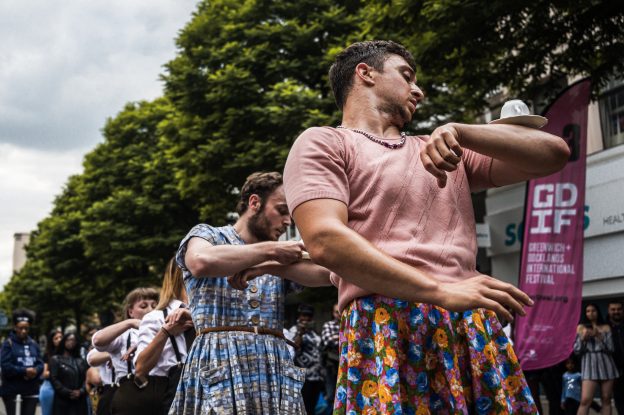When outdoor arts, disability arts and inclusive practice come together: Lily Norton explores how Stopgap Dance Company, Greenwich+Docklands Festival, and the Without Walls consortium are working to bridge the gaps
Two o’clock in the afternoon on Woolwich High Street, South-east London.
A pulsing drumbeat blares from speakers, driving forward the footsteps of Saturday shoppers. The bending notes of an electric guitar warp and shift through the air, drawing bodies in, capturing attention. An ensemble dressed in suits and skirts whips up the space as they dance. A British Sign Language interpreter drives their heel into the ground, keeping time and strumming the air, rhythmically capturing the music in their whole body. The scene builds to a frenzy as a dancer speeds across in their manual wheelchair, dives to the floor and spins their wheel as a tall suit-clad dancer steps onto it and revolves, staring out onto a sea of mesmerised faces.
It’s not easy to capture the atmosphere of an outdoor contemporary dance performance in words, but when watching Frock by Stopgap Dance Company (performed in Woolwich at Greenwich and Docklands International Festival 2021), both the accessibility and immediacy of the festival to local audiences inspired this investigation into outdoor arts, disability arts and inclusive practice.
Before diving into the practical nature of inclusive practice for outdoor arts, it’s important to recognise that in the past fifteen years, outdoor arts and disability arts have often united and engaged with one another, forging their futures in tandem…
Outdoor Arts & Disability Arts – Growing Together
After London was awarded the 2012 Olympics and Paralympics, there was a rush to invest in outdoor arts as a way to animate public spaces all over the country. Coupled with this investment in outdoor arts came the pledge from the London Organising Committee to hold the most closely integrated Paralympic and Olympic games yet, placing them on an equal footing. This spurred on interest and investment in disability arts too, leading to the simultaneous focuses entwining. Sharing his experience from this exciting time of dual development Sho Shibata, executive producer of inclusive contemporary dance company Stopgap Dance, tells us, ‘Outdoor arts organisations have been very committed in supporting disabled artists and inclusive arts organisations to make and platform work from quite early on, but that ambition was really boosted by the awarding of London 2012, with Arts Council England and various local councils committed to supporting disabled-led work’. Sho recalls the ‘big emphasis on outdoor arts organisations engaging with disability arts organisations’, which led to Stopgap Dance Company being commissioned by Shape Arts to create the outdoor work Tracking, which began touring the outdoor circuit in 2009 alongside disabled artists like Marc Brew, Daryl Beeton, and Mark Smith. Though investment and emphasis may have waned since 2012, inclusion and supporting disabled-led work is still a high priority for the sector.
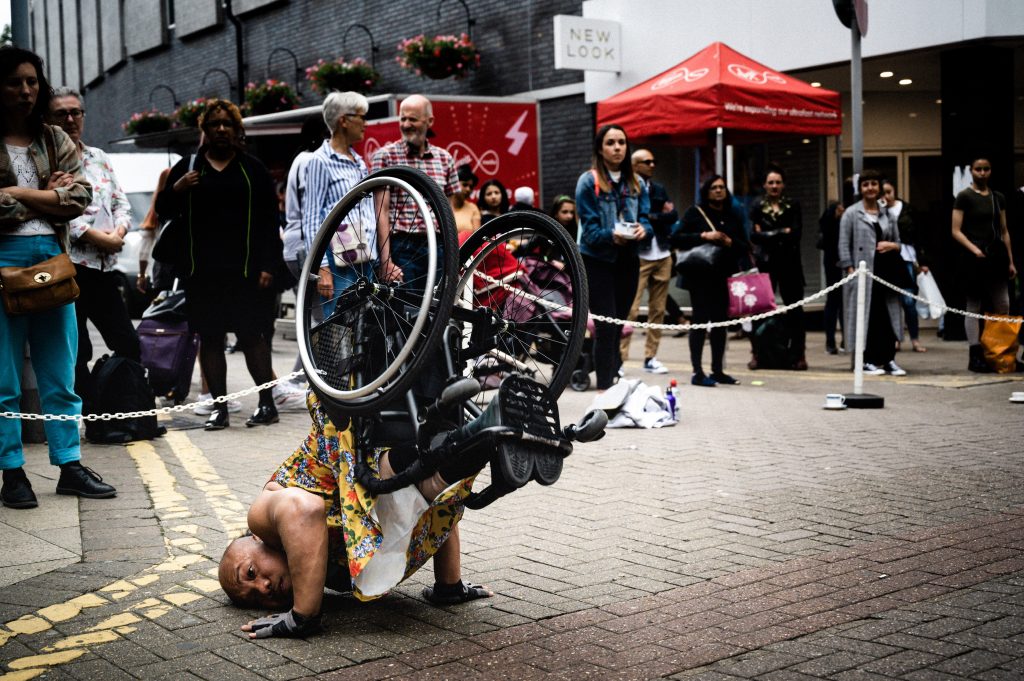
Stopgap Dance: Frock. Photo Chris Parkes. Image Description: Dancer Nadenh balances in a shoulder stand in his wheelchair, his head pressed against the pavement and hands bracing himself as he lifts his lower body and chair into the air. Nadenh is a brown-skinned Cambodian man. He wears a floral yellow dress, black fingerless workout gloves and black trainers. A crowd of people watches in the background.
Outdoor arts is a place for community, for collaboration, for exciting place-based creations to bring arts audiences and general public together to experience everything from contemporary dance and theatre, to circus, to poetry, to visual art. As part of this community commitment, the outdoor arts industry has a responsibility to generate opportunities for D/deaf, disabled and neurodivergent artists to showcase their work to outdoor audiences.
‘Outdoor Arts as a sector is about celebration, bringing communities together and bringing art to the community to engage with, to entertain, to enjoy. It’s really important that everyone who lives in that community are represented – including disabled people,’ says Sho. Festivals and events are much more focused on representing their community through their programming than theatres perhaps are, meaning you see a much more diverse cultural offering. Platforming D/deaf, disabled and neurodivergent artists has many positive impacts on the community. People want to see themselves reflected in work, their lives and experiences echoed and celebrated. Not only does it positively reinforce a sense of self but has a powerful educative impact on wider audiences.
As a disabled artist myself, I’m always excited by the ways outdoor arts creates connections between D/deaf, disabled and neurodivergent (ND) artists and people who’ve never engaged with disabled people and disability arts. Societal perceptions of disabled people, though sluggishly changing, are still overall limited to uncomfortable stereotypes, pity and the belief that we are incapable of leading successful, fulfilling lives. These reductive perceptions of us are challenged when presented with work showcasing skilled creative D/deaf, disabled and ND performers. It can open up a dialogue for audiences to reconsider their views, especially when performances take place in busy areas of high visibility. Reaching local audiences that might not usually be part of an audience for inclusive work programmed in theatres.
With inclusive companies like Stopgap Dance who employ disabled and non-disabled dancers, touring outdoor work also showcases to audiences a more inclusive representation of what dance, culture and society can be. As Sho says ‘for local audiences to be able to see that in their own context is quite unique. I would like to see more commitment from the sector to support disabled dancers and present them in outdoor arts programming’.
However, it’s not a simple fix in programming more D/deaf, disabled and neurodivergent artists when in actuality we are heavily underrepresented in the arts industry. Even before the pandemic, the data in Art Council England’s Diversity Report 2019-2020 made for alarming reading, revealing that the total percentage of disabled people working across NPOs is 7%. Disabled people are not adequately represented in creative industries which feeds into the lack of cultural and societal visibility, further enabling negative perceptions. Considering 21% of people in the UK are disabled, we’re missing out on providing a good chunk of local audiences with work that represents them. Inclusive arts companies are shouldering a lot of responsibility to create change, but they need other organisations to step up; working collaboratively to identify and dismantle barriers for D/deaf, disabled and neurodivergent people. Creating more pathways for future generations of artists. Cultural events and festival organisers shouldn’t be afraid to create opportunities and program D/deaf, disabled and neurodivergent artists for fear of lack of audience, inclusive work often has a core dedicated disabled audience who are committed to supporting it.
Ultimately, it’s critical that when platforming and engaging with D/deaf, disabled and neurodivergent artists and audiences you have a good understanding of accessibility and the ways in which we can be excluded from society and engaging with cultural experiences.
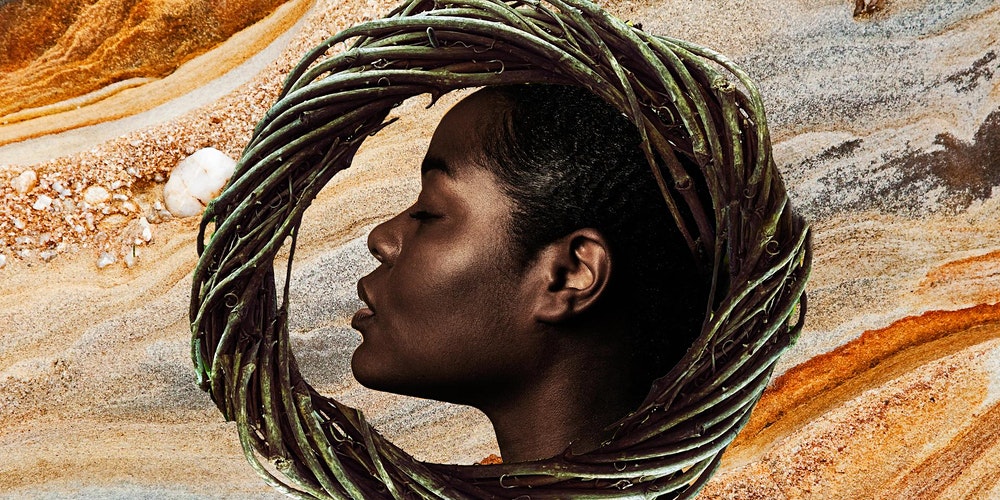
How do we welcome disabled artists and audiences to outdoor arts events?
Making outdoor arts and festivals accessible to audiences takes much more consideration than just plonking a show on a high street and presuming that because you can just stroll up to it and watch, it’s accessible to everyone. Creating an accessible and inclusive environment takes time, thorough planning, and of course, a dedicated budget.
Speaking with Alex Covell, access producer for FESTIVAL.ORG and access advisor for the Without Walls Network, we connected over a shared passion for accessible outdoor arts and explored her approach to coordinating access for over 70 different acts and shows as part of Greenwich and Docklands International Festival (GDIF). In Alex’s words, her role is to ‘ensure the festival is prioritising access and inclusive practice, which involves constant interrogation and consideration to make sure creative access is at the forefront and reflective of the world we live in’.
So, what is access?
Like many, Alex works with the social model of disability and the cultural model of deafness. Those familiar with models of disability will be well aware of the social model, but in essence it works to address barriers society has created, rather than centring the disabled person as being the problem. These barriers encompass attitudes, environments, communication, and organisational systems that all contribute to how society goes about disabling people. The model helps in identifying barriers to then be able to remove and minimise them – providing access to counter exclusion.
An example of this within an outdoor arts context:
A barrier: There are steps that lead to a performance space and no chairs provided to sit and watch. This means wheelchair users cannot access the space and those who have mobility impairments cannot access a performance or stand for a long period and watch.
The solutions: Create a step-free route to your performance space – by either choosing somewhere with level access when doing a site-visit, directing people via a step-free route, or putting in a safe temporary ramp that is wide enough for all types of wheelchairs and mobility aids and has a shallow gradient. Provide seating around the performance space: this seating should also be wide and strong enough to seat all body sizes.
What many do not realise is that these solutions have benefits for many, for example a ramp can be useful for older people and those unsteady on their feet, and for parents and carers with pushchairs. Seating is useful to everyone who would like to rest a little whilst they experience something amazing!
This example addresses a physical barrier, but it’s important to not just solely approach access as physical adaptations. An accessible event or environment means that you have considered and addressed multiple barriers that might exclude people – this includes creating sensory adaptations, access such as sign-language interpretation and captions, audio tours and audio description (which we’ll all come on to in a moment!). Alongside barriers disabled people experience, taking an intersectional approach you will also consider financial and cultural barriers too, which leads to creating a more inclusive space. Inclusive means including everyone, developing a culture of equity where everyone can exist and thrive in the same space.
Access isn’t boring, it can be incredibly enriching to everyone’s experience, and when you start thinking creatively with accessibility you start to open new avenues for artists and their work. Innovators in integrated access, such as Graeae Theatre, develop their work in a way that means it wouldn’t exist without the access. Influencing everything from the characters to the set design, it ensures that every show is accessible to a range of audiences.
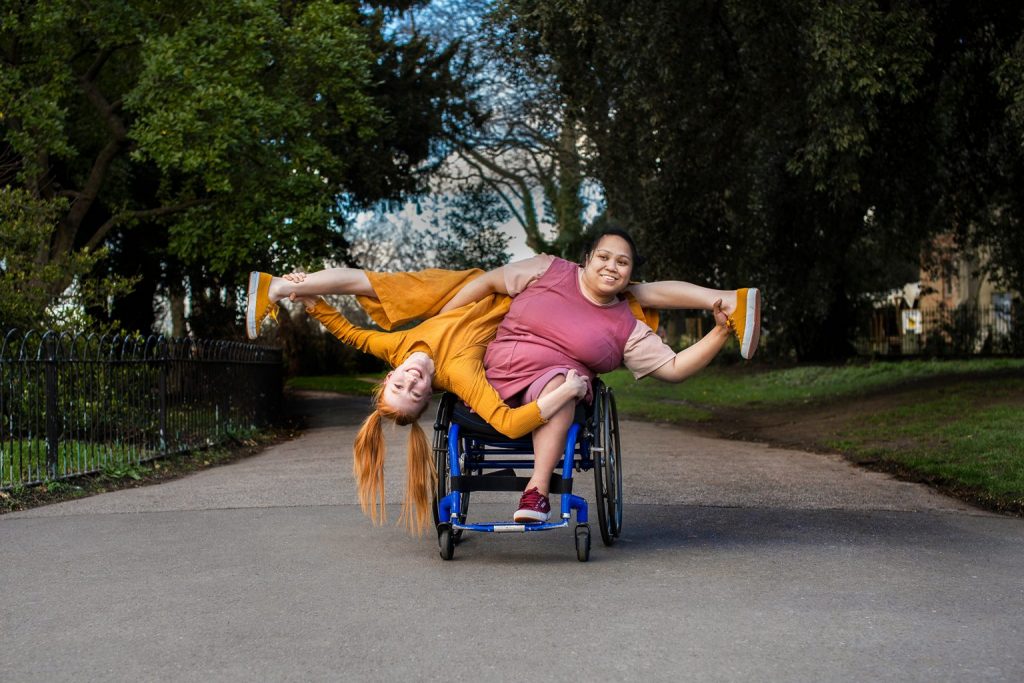
When working with artists for GDIF who are inexperienced with creating access for their show, Alex undertakes an incredibly bespoke approach to each work guided by this framework: ‘the areas I always consider are content, visuals and text’. The form, themes and environment of each programmed work is carefully considered using these three principles, to discover the right approach to maximising accessibility. For some artists this leads to integrating access into the work, and for all artists it generates a variety of forms of accessibility.
Depending on the content of the work, creative but accessibly designed easy-read guides and visual stories are made to help learning disabled and ND audiences understand and access the content of the work. If appropriate, content warnings are issued to support audiences to prepare themselves or to decide if they want to engage.
If visuals are vital to the work, Alex will collaborate with artists on audio description, audio introductions and touch tours, which help to inform audiences of key visual elements, particularly useful for blind and visually impaired people. Alongside being available live, these are hosted online to allow visitors and audience to experience them at any time. For visual artwork and installations, pre-recorded audio introductions and soundscapes are created and hosted online for audiences to listen to whilst experiencing work.
When there is text in the work, it’s BSL interpreted and/or captioned. As referenced in the beginning with Frock from Stopgap Dance, a BSL interpreter captured the music and lyrics within their interpretation, creating a striking visual representation that complimented the choreography. Alex shared an example of a show she’d worked on that only had three small snippets of dialogue, to make it work better for D/deaf and hard-of-hearing audiences it was decided why not just remove those few words? When you really consider access, it shapes the work in unexpected ways.
Alex then has the busy job of organising access for each show based on these three pillars of content, visuals, and text. Working within plenty of time and the sensitive consideration that is integral to accessibility. When creatively considering access, it’s not a quick fix, it takes research, investigation, and conversation. Deeply invested in supporting artists to craft access within the world of their work, it’s felt mutually, as Alex shared that ‘there’s so much openness and artists are really interested in talking about inclusive practice’. These conversations and provocations for artists to widen their accessibility practice opens them up to a world of new considerations for their work, which they can carry forward into future experiences and productions.
What was clear when talking with Alex is that inclusive practice is firmly embedded across the whole of the festival and organisation. Staff and volunteers receive diversity training and contribute to discussions around accessibility for audiences. Inclusive practice is everyone’s responsibility which means accessibility and therefore by extension D/deaf, disabled and neurodivergent audiences, aren’t an afterthought.
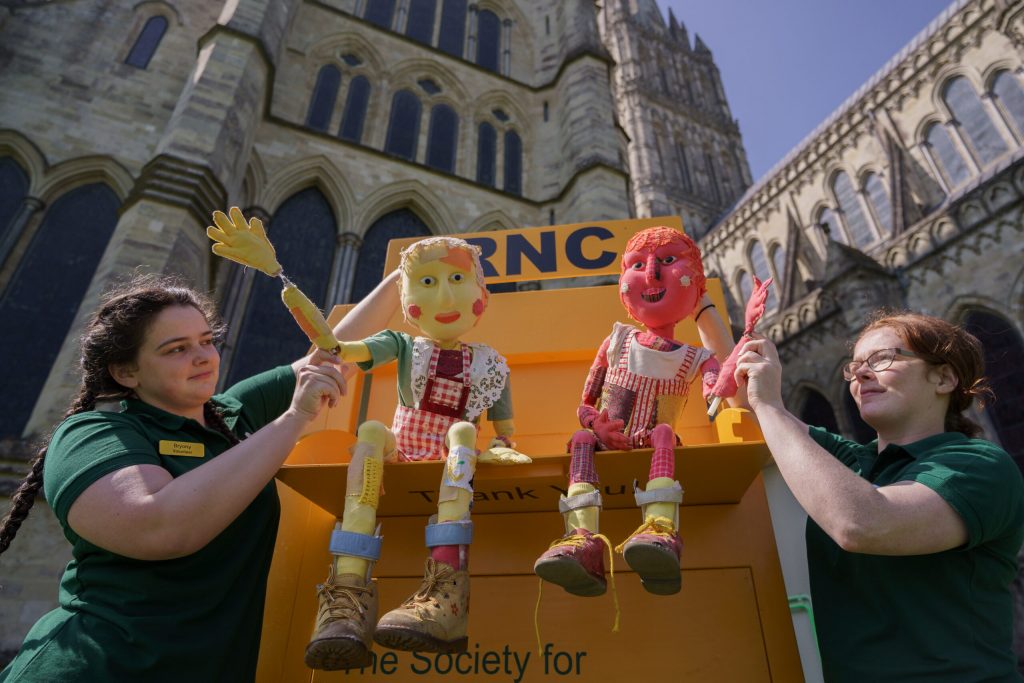
It’s hard to think of any other form of theatre so accepting of noise and commotion, so reflective of place and people. The flexibilty outdoor arts provides can be much more welcoming for disabled audiences, especially as we emerge from the pandemic. We should all work towards creating more accessible and inclusive cultural events. Taking those first steps towards considering access and inclusive practice shouldn’t feel daunting – stride forward knowing that you are enriching everyone’s experience and valuing D/deaf, disabled and neurodivergent people’s engagement.
For anyone wondering where to start
Employ and include D/deaf, disabled and neurodivergent people within your organisation and planning. Not to solely shoulder the responsibility for inclusion and accessibility but to inform approaches through their lived experiences.
Resources Aplenty! So many people are willing to share their knowledge and help you build accessibility into your practice. There’s so much practical guidance out there as well, Without Walls – the Outdoor Arts Consortium have compiled so many great access resources including the comprehensive Access Guide 2020 for Outdoor Arts Festivals and Events.
List what access you have on your event website, including your continued Covid-19 protocol – people like to know beforehand what will be provided. Even if there are only a small number of things you can include, to know you are acknowledging your disabled audience is a place to build from.
Access is creative and enriches your practice when it’s given opportunity to directly interact and inform the work. Create those opportunities and give everyone and everything the time they need.
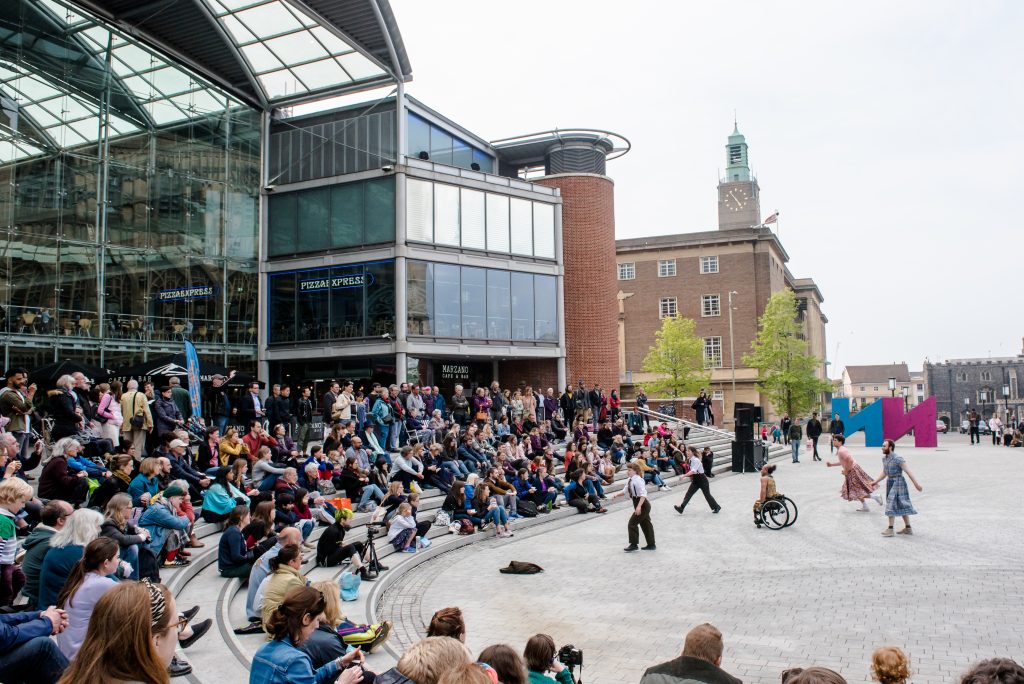
Featured image (top of page): Stopgap Dance: Frock. Photo Chris Parkes. Image description: Image Description: In a line, dancers stand and balance a teacup and saucer on their elbow; in the foreground at the front of the line is a tall male dancer who wears a pink top and floral skirt. In the background leafy trees line the Highstreet and in the corner is a pink banner for Greenwich + Docklands International Festival.
Lily Norton
Moving and creating from a young age, Lily Norton is an autistic dancer, writer and visual artist who works with both traditional and digital media. As an advocate for disability justice and a proud queer, non-binary disabled artist, Lily is passionate about inclusivity and developing creative integrated methods of increasing accessibility to dance and the arts.
Lily Norton took part in the Total Theatre Artists as Writers 2021-2022 programme.
Stopgap Dance Company
Stopgap Dance Company is driven by a diverse creative team who uses dance as a movement for change. Their vision is to create an inclusive world where diversity is not just accepted but pursued, a world where no one is limited by prejudice against D/deaf, disabled, or neurodivergent people.
Their work is both focused on and born out of the company’s rigorous investment in equity and inclusive culture. We are committed to removing barriers to dance, nurturing the talents of dancers born into any body and any mind. We are in coalition with a wave of organisations moving towards a better representation of diversity on our stages and in society.
See https://www.stopgapdance.com/about/
Greenwich + Docklands International Festival (GDIF)
GDIF is London’s leading festival of free outdoor theatre and performing arts. GDIF is committed to breaking new ground in outdoor performance and raising the ambition, quality and diversity of outdoor work produced in the UK.
GDIF forms part of the Royal Greenwich Festivals, an annual series of high-quality events organised by the Royal Borough of Greenwich to celebrate cultural vibrancy, and is the flagship annual event produced by FESTIVAL.ORG.
The 2022 GDIF takes place 26 August to 11 September. Details here: https://festival.org/gdif-2022/
Without Walls
Without Walls is a consortium of over 30 partners working together to create, develop and tour innovative new work and invest in the growth of the outdoor arts sector. Each year, they commission and present a programme of new work that premieres at festivals across the UK.
The consortium is instrumental in developing and maintaining an active touring network for outdoor arts. Many of the shows we have premiered continue to tour nationally and internationally for many years, contributing to England’s position as a global leader in outdoor arts. Without Walls’ network of partners reaches across England from city to country to coastline. Many work in areas of low arts engagement and pioneer new forms of creative engagement with and for their communities. From the East End of London, to the banks of the River Tees in Stockton, the countryside of rural Cheshire, and on to towns centre across the country – Without Walls’ work finds audiences far and wide.
Without Walls is funded by Arts Council England as a National Portfolio Organisation.

